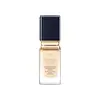Clé de Peau Beauté Radiant Fluid Foundation Matte SPF20 Versus Estée Lauder Double Wear Stay-in-Place Foundation
What's inside
What's inside
 Key Ingredients
Key Ingredients

 Benefits
Benefits

 Concerns
Concerns

 Ingredients Side-by-side
Ingredients Side-by-side

Dimethicone
EmollientWater
Skin ConditioningPolymethylsilsesquioxane
CI 77891
Cosmetic ColorantTitanium Dioxide
Cosmetic ColorantGlycerin
HumectantTrimethylsiloxysilicate
EmollientButylene Glycol
HumectantDiisostearyl Malate
EmollientTalc
AbrasiveCI 77492
Cosmetic ColorantPEG-10 Dimethicone
Skin ConditioningPEG/PPG-19/19 Dimethicone
EmulsifyingPolyglyceryl-2 Diisostearate
EmulsifyingCI 77120
Cosmetic ColorantHydrogenated Polyisobutene
EmollientAluminum Hydroxide
EmollientDimethicone/Vinyl Dimethicone Crosspolymer
Skin ConditioningStearic Acid
CleansingBis-Butyldimethicone Polyglyceryl-3
CleansingDisteardimonium Hectorite
StabilisingPhenoxyethanol
PreservativeCI 77491
Cosmetic ColorantCI 77499
Cosmetic ColorantTrisodium EDTA
Sodium Dehydroacetate
PreservativeDimethicone Crosspolymer
Emulsion StabilisingDisodium Stearoyl Glutamate
CleansingTrehalose
HumectantArgania Spinosa Kernel Oil
EmollientZinc Oxide
Cosmetic ColorantParfum
MaskingTriethoxycaprylylsilane
Polysorbate 80
EmulsifyingAlcohol
AntimicrobialTheanine
EmollientPEG/PPG-14/7 Dimethyl Ether
Skin ConditioningGlycine
BufferingTocopherol
AntioxidantHypericum Erectum Flower/Leaf/Stem Extract
Skin ConditioningRosa Roxburghii Fruit Extract
TonicMica
Cosmetic ColorantAngelica Acutiloba Root Extract
Skin ConditioningSodium Metabisulfite
AntioxidantHydrolyzed Silk
HumectantHydrolyzed Conchiolin Protein
Skin ConditioningPerilla Ocymoides Leaf Extract
TonicDimethicone, Water, Polymethylsilsesquioxane, CI 77891, Titanium Dioxide, Glycerin, Trimethylsiloxysilicate, Butylene Glycol, Diisostearyl Malate, Talc, CI 77492, PEG-10 Dimethicone, PEG/PPG-19/19 Dimethicone, Polyglyceryl-2 Diisostearate, CI 77120, Hydrogenated Polyisobutene, Aluminum Hydroxide, Dimethicone/Vinyl Dimethicone Crosspolymer, Stearic Acid, Bis-Butyldimethicone Polyglyceryl-3, Disteardimonium Hectorite, Phenoxyethanol, CI 77491, CI 77499, Trisodium EDTA, Sodium Dehydroacetate, Dimethicone Crosspolymer, Disodium Stearoyl Glutamate, Trehalose, Argania Spinosa Kernel Oil, Zinc Oxide, Parfum, Triethoxycaprylylsilane, Polysorbate 80, Alcohol, Theanine, PEG/PPG-14/7 Dimethyl Ether, Glycine, Tocopherol, Hypericum Erectum Flower/Leaf/Stem Extract, Rosa Roxburghii Fruit Extract, Mica, Angelica Acutiloba Root Extract, Sodium Metabisulfite, Hydrolyzed Silk, Hydrolyzed Conchiolin Protein, Perilla Ocymoides Leaf Extract
Water
Skin ConditioningCyclopentasiloxane
EmollientTrimethylsiloxysilicate
EmollientPEG/PPG-18/18 Dimethicone
EmulsifyingButylene Glycol
HumectantTribehenin
EmollientPolyglyceryl-3 Diisostearate
EmulsifyingMagnesium Sulfate
Tocopheryl Acetate
AntioxidantPolymethylsilsesquioxane
Methicone
EmollientLaureth-7
EmulsifyingXanthan Gum
EmulsifyingAlumina
AbrasiveSodium Dehydroacetate
PreservativeDisteardimonium Hectorite
StabilisingCellulose Gum
Emulsion StabilisingPropylene Carbonate
SolventPentaerythrityl Tetra-Di-T-Butyl Hydroxyhydrocinnamate
AntioxidantPhenoxyethanol
PreservativeIron Oxides
Mica
Cosmetic ColorantCI 77891
Cosmetic ColorantWater, Cyclopentasiloxane, Trimethylsiloxysilicate, PEG/PPG-18/18 Dimethicone, Butylene Glycol, Tribehenin, Polyglyceryl-3 Diisostearate, Magnesium Sulfate, Tocopheryl Acetate, Polymethylsilsesquioxane, Methicone, Laureth-7, Xanthan Gum, Alumina, Sodium Dehydroacetate, Disteardimonium Hectorite, Cellulose Gum, Propylene Carbonate, Pentaerythrityl Tetra-Di-T-Butyl Hydroxyhydrocinnamate, Phenoxyethanol, Iron Oxides, Mica, CI 77891
 Reviews
Reviews

Ingredients Explained
These ingredients are found in both products.
Ingredients higher up in an ingredient list are typically present in a larger amount.
Butylene Glycol (or BG) is used within cosmetic products for a few different reasons:
Overall, Butylene Glycol is a safe and well-rounded ingredient that works well with other ingredients.
Though this ingredient works well with most skin types, some people with sensitive skin may experience a reaction such as allergic rashes, closed comedones, or itchiness.
Learn more about Butylene GlycolCi 77891 is a white pigment from Titanium dioxide. It is naturally found in minerals such as rutile and ilmenite.
It's main function is to add a white color to cosmetics. It can also be mixed with other colors to create different shades.
Ci 77891 is commonly found in sunscreens due to its ability to block UV rays.
Learn more about CI 77891Disteardimonium Hectorite comes from the clay mineral named hectorite. It is used to add thickness to a product.
It can also help stabilize a product by helping to disperse other ingredients.
Hectorite is a rare, white clay mineral.
Learn more about Disteardimonium HectoriteMica is a naturally occurring mineral used to add shimmer and color in cosmetics. It can also help improve the texture of a product or give it an opaque, white/silver color.
Serecite is the name for very fine but ragged grains of mica.
This ingredient is often coated with metal oxides like titanium dioxide. Trace amounts of heavy metals may be found in mica, but these metals are not harmful in our personal products.
Mica has been used since prehistoric times throughout the world. Ancient Egyptian, Indian, Greek, Roman, Aztec, and Chinese civilizations have used mica.
Learn more about MicaPhenoxyethanol is a preservative that has germicide, antimicrobial, and aromatic properties. Studies show that phenoxyethanol can prevent microbial growth. By itself, it has a scent that is similar to that of a rose.
It's often used in formulations along with Caprylyl Glycol to preserve the shelf life of products.
Polymethylsilsesquioxane is a silicone used as a film forming agent.
When applied to the skin, this ingredient creates an invisible film on the surface. This film still allows oxygen to pass through, but prevents moisture from escaping. This can help condition and hydrate the skin. It also leaves a silky feel when applied.
Polymethylsilsesquioxane has not been shown to clog pores. It has been deemed safe to use up to 55%, but most cosmetics use much less.
If you have concerns about using this ingredient, we recommend speaking with a professional.
Learn more about PolymethylsilsesquioxaneThis ingredient is a preservative with antimicrobial properties. It is the sodium salt of dehydroacetic acid.
It is especially effective at preventing bacterial and fungal growth in low concentrations.
This silicone is an emollient. Emollients create a thin film on the skin to prevent moisture from escaping.
It is not soluble in water and helps increase water-resistance in products.
According to a manufacturer, it can blend seamlessly with silicone oils, such as Cyclopentasiloxane.
Learn more about TrimethylsiloxysilicateWater. It's the most common cosmetic ingredient of all. You'll usually see it at the top of ingredient lists, meaning that it makes up the largest part of the product.
So why is it so popular? Water most often acts as a solvent - this means that it helps dissolve other ingredients into the formulation.
You'll also recognize water as that liquid we all need to stay alive. If you see this, drink a glass of water. Stay hydrated!
Learn more about Water